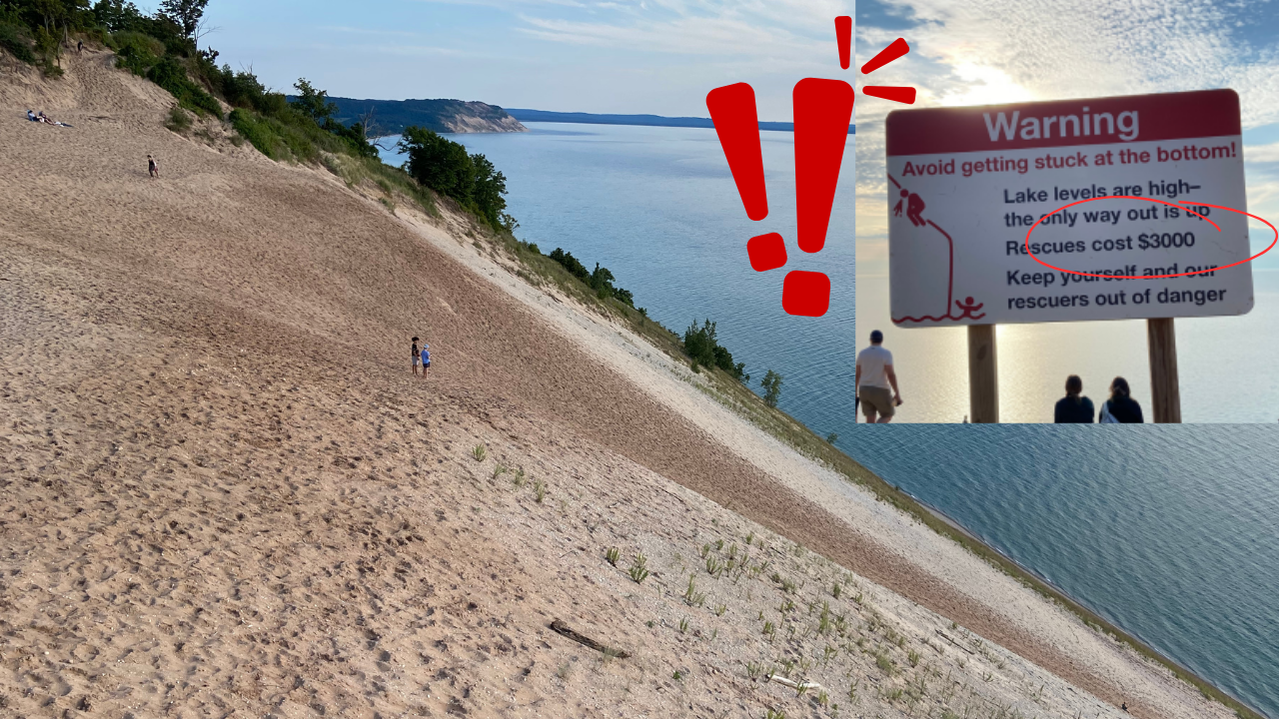The 3 Best Hikes in Sleeping Dunes National Lakeshore
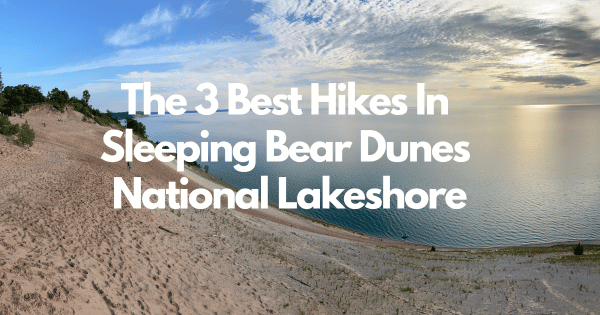
Written by Nancy Carter, Making My Own Lane
The Three Best Hikes In Sleeping Bear Dunes National Seashore
The famous dunes of Sleeping Bear Dunes National Lakeshore were sculpted by the advance and retreat of huge glaciers of the past two million years.
It is the world’s largest collection of freshwater sand dunes, with formations that rise up to 400 feet above the lake.
Sleeping Bear Dunes is not a National Park, but a National Lakeshore. At the same time, it does fall under the National Park Pass that I will talk more about a little later.
Also, if you download the NPS app, you can find guided audio tours and the history of the park, and all the parks that fall under “National Park” status, even if they aren’t officially National Parks.
For some reason, I only allowed myself 24 hours at Sleeping Bear Dunes.
Actually more like 18 hours, after I checked in and got my bearings.
I checked into the campground, set up my site, and headed out to explore around 6 pm.
When visiting the dunes in the summer, it will stay light out until almost 9:30 pm, so I had 3 hours to hike.
The park ranger had recommended that I head north from Platte River Campground, a National Lakeshore Campground, to
Pierce Stocking Scenic Drive
The drive is a 7.4 mile loop with 12 numbered points of interest.
Hint - Download the NPS app and pull up Sleeping Bear Dunes for a guided, narrated tour as you get to each stop.
At the Number 9 stop of the Scenic Drive, you will find the 284-foot, 45 degree world famous Dune Drop down soft, white sand. It is about the equivalent of an 11-story building.
From the top of the highest dune it is 450-feet down to Lake Michigan; however the place most people start their decline is at the 284-foot mark.
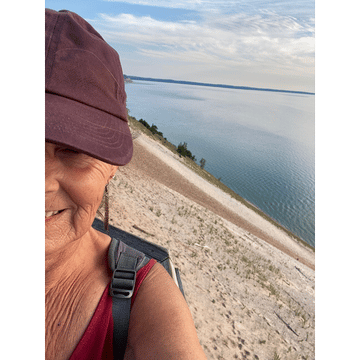
There is a sign clearly stating the $3,000 fine
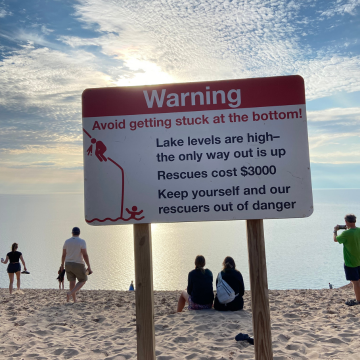
if you run down to the bottom and need to be rescued to get back up. Although I did see one group of people run down to an awaiting boat, and completely avoid the climb back to the top. It almost felt like they were cheating 😂.
This is the one most popular hike that you see on social media all the time that some people climb for fun.
You can also explore the dunes from the top, where there is a wooden observation deck, and some hiking trails for a beautiful view of Glen Lake, and more dunes you can climb to the top of.
Hint - If you’re not sure about attempting the hike down to Lake Michigan, and back up, try climbing these dunes first to see how you do.
I found it pretty strenuous climbing in the soft sand and it solidified my decision to NOT attempt the big dune drop.
The evening I was there in early August was not crowded.
I did stay and watch some people to see how long the hike took, and I timed them at 45 minutes. But I’ve also heard that the average time is a little over an hour, with some people taking as long as 3 hours.
Pets are not allowed on the dunes.
Next I drove south, back towards the campground, to
Empire Bluff Trail
Another ranger recommendation. I always ask the rangers, either at the campground check in area or at the Visitor's Center, where the best places are to go. Especially if I am limited on time, like on this one-night stop.
The trail is about 1.5 miles, and it leads to an overlook where you can admire the entirety of the dunes, and watch an amazing sunset.
You can bring your dog, as long as they are on a leash no longer than six feet, but remember it is a three-mile hike total, if you have a short-nose, small dog with less stamina, like Willie.
After walking for about 30 minutes, I almost turned around. It was getting dark and I wasn’t sure what I would even find at the end. So I checked my Waze, and saw I was at least on the right trail, and I kept on going. I'm so glad I did.
There were benches to sit on, and it seemed to be a very popular place to watch the sunset.
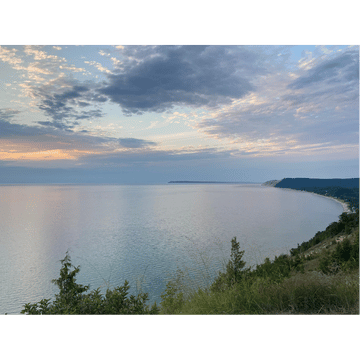
As a solo traveler, I appreciated this because it meant I had people to walk with on the 1.5 miles back to my car, in semi-darkness after the official setting of the sun.
The total hike, and sunset watching, took about an hour and a half.
The next morning, I decided to do one more hike before I left.
Platte River Campground to Lake Michigan via Railroad Grade
This was a 2.5 mile hike from the campground parking lot. My site was in Loop 1, the farthest from the lot, but a loop that had electric hookups.
So for me, it was about a 3.5 mile hike.
The hike was very wooded and flat most of the way. The mosquitoes and biting flies were making me wish I had brought bug spray.
The last half mile or so I found myself back in soft, deep, white sand which was more strenuous to walk through.
The hike one way took about 45-minutes, and I almost turned back because I had to check out and move on that day. I've had a lot of those situations lately, where I was almost ready to turn back.
And again, I would have missed so much.
After looking on Waze again to see how much farther away Lake Michigan was, I kept on going, and found myself the only person on the most beautiful beach I have ever been on.
The beach was natural and pristine, and the water super clear (and cold for this Florida girl).
I sat down at the water’s edge for a while, just to take in the beauty of the location and celebrate sticking my toes in Lake Michigan, my fifth Great Lake, before heading back
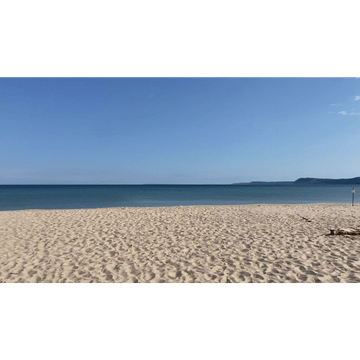
Pets were not allowed on the beach part of this trail. There were signs when you got to to the sandy part to remind you, no dogs allowed.
Are pets allowed on the trails?
Pets are not allowed on the Dune Climb trail and many of the beaches. In the areas they are allowed, they need to be kept on a leash no longer than six feet long.
Be sure to check the rules for your hike before you start so that you are able to complete your hike and see all the beauty of this park.
Is there an entrance fee for Sleeping Bear Dunes National Park?
There is a $25 vehicle pass needed to access and park within the park. You can purchase a pass at the Phillip A. Hart Visitor Center, The Pierce Stocking Scenic Drive, the Dune Climb, the Homestead, or at the ranger office if you are staying in the campground.
Hint - if you will be visiting more National Parks in a one-year period, you can purchase a yearly National Parks America the Beautiful pass for $80 at the above location.
I was thrilled to be able to purchase my Silver National Parks pass this year! When you turn 62, you can purchase this pass for $80 and it is good for the rest of your life! Just don't lose it, or you will have to buy a new one.
My birthday was the day I chose to visit Sleeping Bear Dunes, so I was able to purchase my Lifetime Silver pass right at the campground.
Bring the proper gear for your hike
You don’t need a lot, but I would recommend a few things to make your hikes in Sleeping Bear Dunes more enjoyable.
1. Proper hiking shoes. The trails can be wet and muddy in spots, and sandy. Wearing shoes with non-slip soles helps if your feet get wet, but I did just end up taking my shoes off in the dunes.
My favorite hiking shoe is a hiking sandal, that lets my feet breath and expand, as my feet often do as the day goes on.
If you would like to know more about my hiking sandals, message me here.
2. Water. It’s always worth having a bottle of water with you, even for a short hike. You never know.
3. A light snack. I usually carry an Uncrustable frozen peanut butter and jelly sandwich with me. Sometimes you can find a wheat bread version. It gives you an extra jolt of protein to keep going, and it’s easy to carry.
4. Use the bathroom before you start your hike. There are facilities at the beginning of the hikes I talk about today.
5. Bring your cell phone. Even when service was limited or non-existent, like many national parks, I was able to access my route on Waze.
6. Bug spray. The hike from the Platte River Campground to Lake Michigan had so many mosquitoes in the wooded part of the hike. I did not have bug spray with me, but I really wish that I did. Now I just keep a bottle in my hiking backpack, just in case.
The Legend of Manitou Islands and the Sleeping Bear
“Once, long ago, in the land called Wisconsin across the great lake, there was a terrible hunger and many people died. A bear and two little cubs were trying to leave that place and come around the lake where there would be more food.
They waited for many days on the beach together. But after a while the two little cubs began to whimper with hunger, and so the bear decided to swim across the rest of the lake.
They waded into the water, one cub on each side of the bear, and they swam off into the lake a long way. After a while the cubs began to get very tired, and so the bear said, 'Try hard, the land is not very far.' And very soon they did come in sight of the land. But gradually the cubs got weaker, and only ten miles away, one cub sank into the water. Soon after the other also drowned.
The bear’s heart was broken, but she could do nothing. She waded ashore and lay down, looking out on the water where her cubs had died. Eventually, both of they came to the surface as two little islands, and so the bear still lies there atop the dunes, looking after her children.”
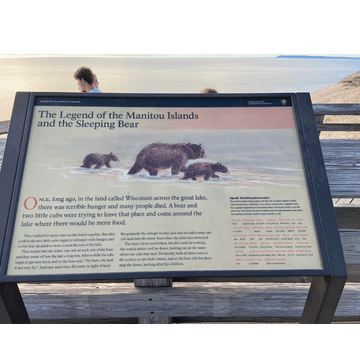
Is there any wildlife at Sleeping Bear Dunes National Seashore?
There were lots of birds, and bugs. I saw a black squirrel, but I wasn’t able to get a picture.
In the campground, they warn you to use bear precautions with your food, as a precaution to make sure they don’t have bear visitors.
Where can you stay in Sleeping Bear Dunes National Seashore?
I stayed at Platte River Campground, at the south end of Sleeping Bear Dunes. It was a well-paved, easy to access campground that was about a 20-minute drive to get up to the dunes.
The site I chose was in Loop 1, with electricity. Many of the loops do not have electricity, so be sure you know what you’re getting before you press that book now button.
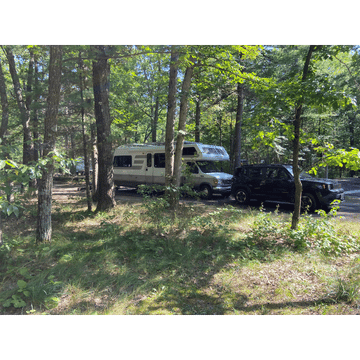
There was a dump station and a place to fill your tanks with potable water, if you needed to do so.
Book your campsite as far in advance as possible. They allow up to nine months in advance. I had no trouble finding a site four months in advance, but there was no additional availability during my stay, except for non-electric sites.
Go to recreation.gov to book your reservation.
The sites were large and fairly spread out, and I had plenty of room to unhook and store my tow dolly. They have a great camp store where you can get firewood and other camping related items.
There is also a more rustic campground available with dirt roads and vault toilets, D.H. Day Campground.
Is it worth going to Sleeping Bear Dunes National Lakeshore?
YES! My only regret is that I didn’t book two nights in the campground, but I am happy with what I was able to do what I did in less than 24 hours.
If you have any comments, suggestions or questions about Sleeping Bear Dunes National Lakeshore, or if you would like to know when I publish a new article, you can message me here.
Thanks for joining me as I continue Year 2 of this full-time RV life.
Subscribe below for updates as we travel and continue to enjoy and learn more about life on the road.
Thank you for subscribing!
Have a great day!

Hi there! I'm Nancy.
In 2023, I ditched my heels for hiking boots, sold my house, and decided to travel the US full time in my 2005 Lazy Daze Class C RV.
I love to share the places I travel to and what it's like to live in an RV full-time.
If you have ever thought about hitting the road and traveling in an RV, either in your free time or full time, you are in the right place!
Follow along for weekly blog posts about my adventures as I travel the US with my two dogs, Rufus and Willie, and my cat, Katie.
